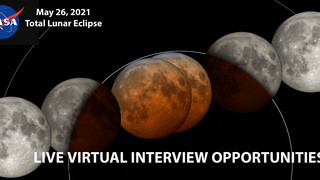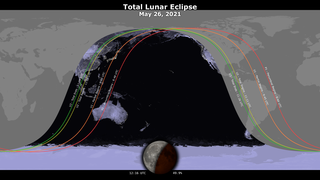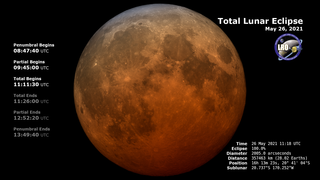Planets and Moons
ID: 4903
On May 26, 2021, during early morning in the western Americas, the Moon enters the Earth's shadow, creating a total lunar eclipse, the first in almost two and a half years. This animation shows the changing appearance of the Moon as it travels into and out of the Earth's shadow, along with times at various stages. Versions of the animation have been created for both Universal Time (UTC) and Pacific Daylight Time (PDT) — within the U.S. Lower 48, those in the Pacific time zone are best situated to see the eclipse.
The penumbra is the part of the Earth’s shadow where the Sun is only partially covered by the Earth. The umbra is where the Sun is completely hidden. The Moon's appearance isn't affected much by the penumbra. The real action begins when the Moon starts to disappear as it enters the umbra at about 2:45 a.m. Pacific Daylight Time. An hour and a half later, entirely within the umbra, the Moon is a ghostly copper color. For this relatively shallow eclipse, totality lasts only 15 minutes before the Moon begins to emerge from the central shadow.
The view in these animations is geocentric. Because of parallax, the Moon's position against the background stars will look a bit different for observers at different locations on the surface of the Earth. The Moon is in the constellation Scorpius. The two bright stars in the upper right are ω1 and ω2 Scorpii.
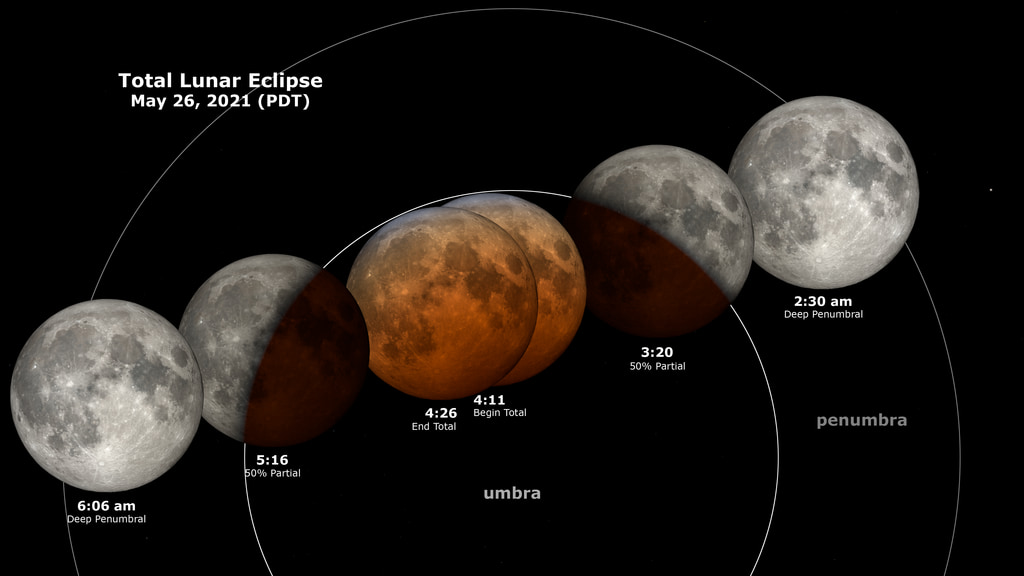
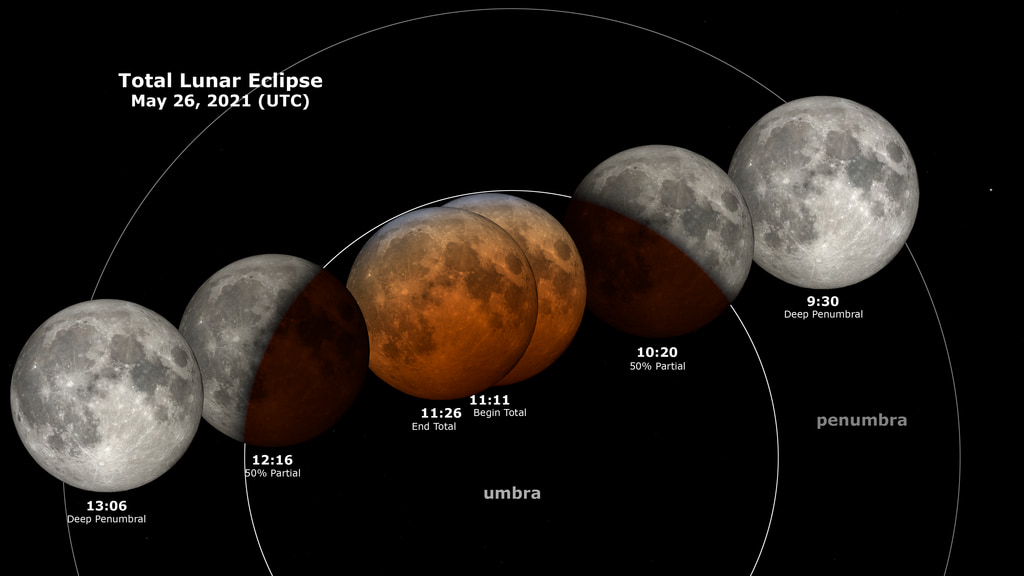
May 26, 2021 Total Lunar Eclipse: Shadow View
The penumbra is the part of the Earth’s shadow where the Sun is only partially covered by the Earth. The umbra is where the Sun is completely hidden. The Moon's appearance isn't affected much by the penumbra. The real action begins when the Moon starts to disappear as it enters the umbra at about 2:45 a.m. Pacific Daylight Time. An hour and a half later, entirely within the umbra, the Moon is a ghostly copper color. For this relatively shallow eclipse, totality lasts only 15 minutes before the Moon begins to emerge from the central shadow.
The view in these animations is geocentric. Because of parallax, the Moon's position against the background stars will look a bit different for observers at different locations on the surface of the Earth. The Moon is in the constellation Scorpius. The two bright stars in the upper right are ω1 and ω2 Scorpii.


Related
Visualization Credits
Ernie Wright (USRA): Lead Visualizer
David Ladd (USRA): Producer
Noah Petro (NASA/GSFC): Scientist
Laurence Schuler (ADNET Systems, Inc.): Technical Support
Ian Jones (ADNET Systems, Inc.): Technical Support
David Ladd (USRA): Producer
Noah Petro (NASA/GSFC): Scientist
Laurence Schuler (ADNET Systems, Inc.): Technical Support
Ian Jones (ADNET Systems, Inc.): Technical Support
Please give credit for this item to:
NASA's Scientific Visualization Studio
NASA's Scientific Visualization Studio
Short URL to share this page:
https://svs.gsfc.nasa.gov/4903
Data Used:
Note: While we identify the data sets used in these visualizations, we do not store any further details nor the data sets themselves on our site.
Keywords:
SVS >> HDTV
SVS >> Lunar
SVS >> Moon
SVS >> Hyperwall
SVS >> LRO
SVS >> Lunar Reconnaissance Orbiter
SVS >> Eclipse
SVS >> Lunar Eclipse
NASA Science >> Planets and Moons
https://svs.gsfc.nasa.gov/4903
Data Used:
LRO/LOLA/Digital Elevation Map also referred to as: DEM
JPL DE421 also referred to as: DE421
Ephemeris - NASA/JPL
Planetary ephemerides
Lunar Reconnaissance Orbiter/LRO Camera/Natural Color Hapke Normalized WAC Mosaic also referred to as: LROC WAC Color Mosaic
Mosaic - Arizona State University
This natural-color global mosaic is based on the 'Hapke normalized' mosaic from LRO's wide-angle camera. The data has been gamma corrected, white balanced, and range adjusted to more closely match human vision.
Keywords:
SVS >> HDTV
SVS >> Lunar
SVS >> Moon
SVS >> Hyperwall
SVS >> LRO
SVS >> Lunar Reconnaissance Orbiter
SVS >> Eclipse
SVS >> Lunar Eclipse
NASA Science >> Planets and Moons
